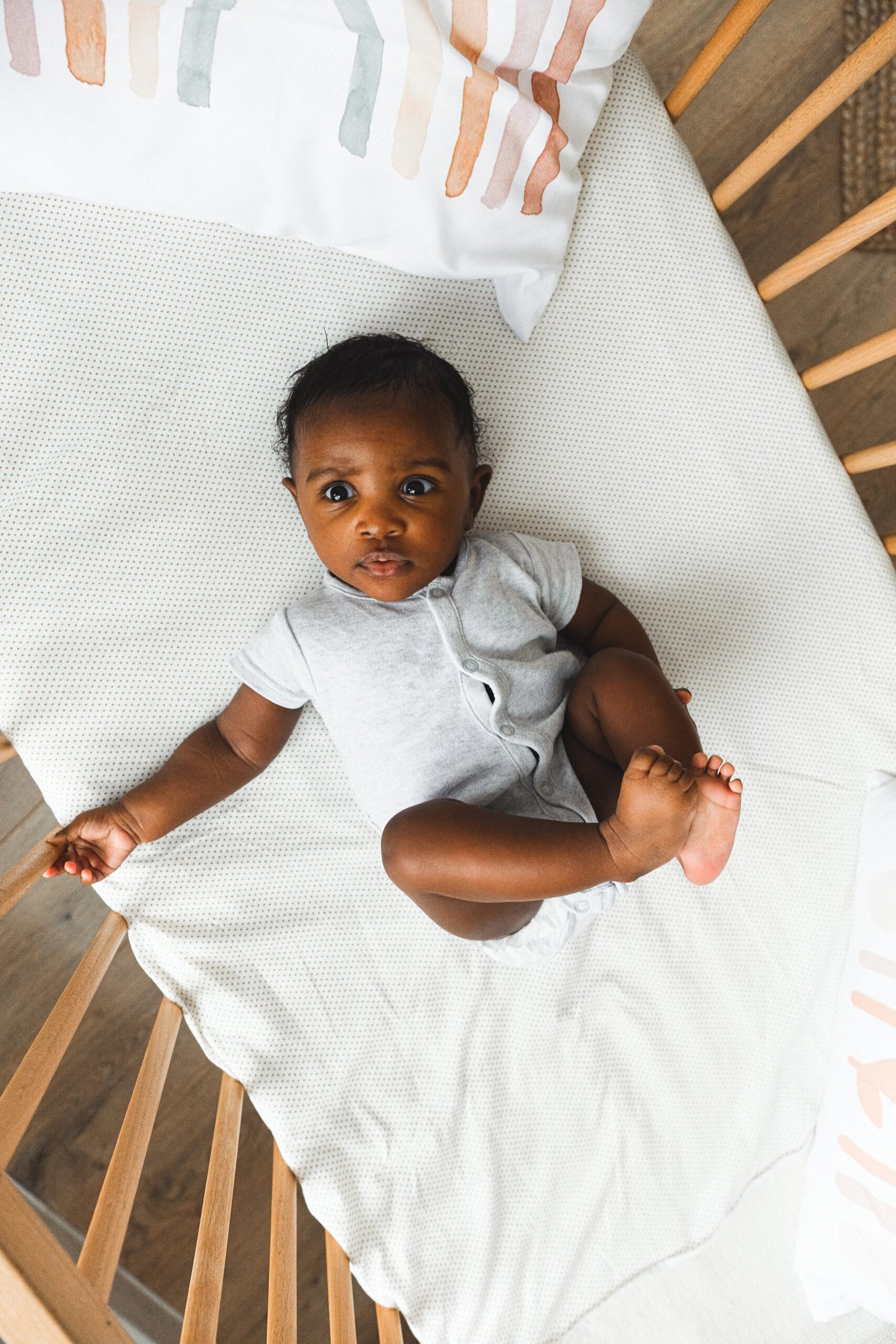I'm Rachael
Mom of 3 & Baby Sleep Expert with Big Sis Energy
& I’VE DONE ALL THE RESEARCH FOR YOU ALREADY.
Better sleep for the entire family
BROWSE COURSES
hey!
toddler sleep issues: night terrors, regressions, and bedtime battles
There is so much information available about baby sleep but for toddler sleep, what’s available seems scarce. I am a huge advocate of supporting your baby to sleep but the same is also true for your toddler and bigger kids. Here is what we’ll discuss in this post:
Why is toddler sleep getting worse?
Often toddlers will need more help falling asleep than newborns, see the testimonies here! Children don’t just stop needing us once they aren’t babies anymore. During the toddler years, children are developing rapidly and as a result, often need an abundance of closeness to stay regulated. Their young brains are now more aware of changes that are happening and this can be unsettling for them and the reason that your toddler won’t sleep without you. You may even notice that your previously amazing sleeper needs a lot more of your presence and reassurance now that they’re older than they did as a baby. This is normal among sleep trained and non-sleep trained babies alike.
the 24-month sleep regression
In the infant sleep world, you will often hear about the sleep regression at age 2. What are sleep regressions, anyway? They’re mostly just big bursts of development paired with other common phenomenon like separation anxiety, teething, etc. They cause little “perfect storms” around certain ages. The only actual change in infant sleep architecture happens at the four-month mark, and the other sleep progressions can be linked to developmental changes that can make it really hard for little ones to take good sleep. When talking 2 year olds, keep in mind:
-
Toddlers’ sleep needs have decreased over 24 hours.
-
The nap becomes harder to get and the length and timing of the nap can then have an impact on bedtime.
-
Night waking and nursing is still normal although at this point is becoming exhausting for parents.
-
Regulation difficulties with big emotions are occurring.
-
Toddlers experience developmental explosions.
There is no set age that any of these things can happen but it normally occurs somewhere between 1 and 3. More information about toddler brain development and sleep can be found here.
so what exactly causes toddler night wakings?
There are lots of reasons why your toddler is waking through the night but the most common are:
-
Sleep cycles. We all wake between sleep cycles in the night and depending on lots of factors sometimes we can link cycles smoothly and other times we need more input. This can be due to several things such as temperament, physical needs, environment, etc.
-
Feeding – Many toddlers still wake to feed in the night. The magical milestone of one year doesn’t just cue the end of night feedings. Many toddlers still breastfeed for a long time after their first birthday. They could also be waking due to thirst – as adults, lots of us take glasses of water to bed to sip throughout the night. Though if you are looking for a change and you do want some extra support to limit night feedings check out my night weaning webinar and course.
-
Rapid brain development – Toddler’s brains are expanding at such a rate that they can find it disconcerting. They now have an increased awareness of separation from their caregiver, their imagination is developing which can lead to night terrors and nightmares, the development of physical skills is occurring and for many toddlers’ huge changes such as potty learning and starting preschool are taking place. All these things together can mean your toddler may need more support through the night.
when toddler waking is not normal
As with all childhood sleep, we do need to be aware of when night wakings are not normal. If your child is waking multiple times a night and it’s taking them a long time to resettle and fall back asleep or they are unhappy and groggy and tired during the day then it is worth taking a deeper look.
If your child snores or sleeps with their mouth open, this is another thing that could be impacting them. These are red flags to be aware of.
If your concerned that your child is showing a “red flag” for sleep you can reach out to us for support!
a deeper look at night terrors
Night terrors are a type of parasomnia, classified as an arousal disorder that occurs during non-REM sleep. They usually occur during the first 3-4 hours of the night and are most common in children aged 3-12. Although your child may appear to be afraid of something or someone in the room, attempts to wake them often prove unsuccessful. They may look awake and be crying or flailing. Often they will be inconsolable during the episode but will fall back into a deep sleep and will have no memory of the disturbance in the morning. Night terrors typically last around 10 minutes but they can last up to 30-40 minutes. They tend to come about in times of high stress or separation or when a child is sick. Here are some of my tips for identifying and handling night terrors in toddlers.
Night terrors can be really scary for the parent to witness. It’s best to NOT try and wake your child up but to just keep them safe and wait for the night terror to pass.
If the night terror always happens at the same time, you might do a “dream pee” for your child right before they normally occur (maybe 5-10 minutes earlier or so) by gently waking them, letting them go pee, and tucking them back in.
You an also “reset” the brain if they occur at the same time every night by lightly rousing your child a few minutes before the usual time of the night terror, and offering a drink of water or something, then letting them fall back to sleep.
Night terrors are often developmental and can go away with age. They also can be due to overtiredness, so try playing with your child’s schedule to see if that helps.
A nightmare is a little different. A nightmare occurs during REM sleep. It’s a frightening and vivid dream that can happen to any child. They may remember the dream come morning or it might wake them up.
Some reassurance and perhaps a nightlight can be helpful if your child has frequent nightmares. Assure them that they are safe and that you are there to protect them. Letting them know they’re always welcome in your room can be helpful, too, or setting up a floor bed should you need to room share with them for part of the night can be useful as well.
Nightmares tend to increase in times of stress, change, etc. and commonly start around ages 3-5 when imagination is growing.
Getting curious is key! Has your child been exposed to a scary show or movie? Is there something in their room making a noise or casting a shadow that’s scaring them? Sometimes nightmares are random and the best thing we can do is assure them that they are safe and that we are there to protect them. Some reassurance and perhaps a nightlight can be helpful if your child has frequent nightmares. Letting them know they’re always welcome in your room can be helpful, too, or setting up a floor bed should you need to room share with them for part of the night can be useful as well.
If it doesn’t seem like a nightmare OR a night terror is happening, it could be something else, called a confusional arousal. If your child is waking at night and seeming confused, or is just calling or crying out but don’t seem “awake” it could be a “confusional arousal.” These are like less-extreme night terrors and pass on their own. Try not to wake your child up but just comfort and keep them safe until they fall back asleep.
If your child is waking up at night and is alert but screaming or crying, rule out pain or discomfort with your doctor.
If you’re experiencing anything like this, it’s always a good idea to write down what happened and take video if possible to share with your healthcare team.
toddler bedtime battles
If you have been following me for a while then you will know how much I love bedtime routines and sleep associations. These are so important for toddlers as the predictability of the routine helps their active toddler brains to calm down. Ensuring the routine is long enough to help them wind down but not too long as to float into play territory is crucial. Many toddlers attend daycare settings and the bedtime routine is a great time to reconnect after a bout of separation. This reconnection time helps to fill up their cups before the long separation of nighttime sleep.
Ensuring good sleep hygiene is also crucial especially when your toddler will not go to sleep. Limiting screens in the afternoon, keeping the environment calm and dark enough, ensuring your toddler has had enough outdoor time, etc. If your toddler is fighting sleep and bedtime feels hard to achieve then try and play with the timing and length of their nap as well as bedtime.
One evidence-based intervention is the fading technique. This involves pushing back bedtime to create much-needed sleep pressure. By doing this you can shorten the time it takes to fall asleep and break the association of bedtime being stressful. Once you have achieved this you can begin to bring bedtime forward again with the new associations in place. A more in-depth look at this can be found in this blog post.
managing toddler sleep with siblings
Many families are managing two bedtimes with a toddler and a baby. This is a really hard season to be navigating but here are some of my favorite tips if you are alone and your baby won’t be put down in their crib.
-
Babywear or keep your newborn skin to skin as you connect with your toddler and support them to sleep.
-
Nurse your infant as you read books and sing songs with your toddler whilst lying in your toddler’s bed.
-
Opt for a large floor bed so that you can all lie down together and sneak out with the baby once your toddler is asleep or vice versa and all fall asleep in your bed and transfer your toddler once they are asleep.
-
This may be a moment for a supervised baby container (if your baby’s temperament allows it) so that you have some hands-free time for your toddler.
-
Sibling sleep issues don’t last forever but if you would like some more support find it here.
Toddler sleep can be just as much of a minefield as baby sleep. If you are wondering how to address your toddler’s sleep or would like more information and advice on approaching certain elements of toddler sleep it can be found in my Better Bedtimes Guide. In this guide we discuss tips for supporting your child with connection-based strategies to ease separation anxiety, fears, stalling or negotiating at bedtime, and other stressful situations to bring the calm back to your evening routine!
If you are looking to make some changes to your toddler’s sleep (like moving away from rocking or cosleeping) but want to do it in a gentle way, check out my Tender Transitions Course.
Was this helpful? Save it for later!
binge reads
We think you'll love these
You deserve to the
baby stage, not just "survive it."
And you DON'T have to sacrifice your values, ignore your instincts, or force yourself to follow a method you don't align with just to get your baby back to sleep.
I’m here to help you create a restful, sustainable sleep environment that honors both your baby’s needs AND your own (without the stress OR the guilt!) because, no, you don’t have to choose between the two.
enjoy!
BABY SLEEP COURSES →
BABY SLEEP CONSULTS →
Wish you could help your baby sleep better without resorting to sleep training? Download my FREE guide to a good night’s sleep and learn 8 simple, science-backed tips for supporting your child’s needs.
Traditional sleep training methods don’t have to be your solution to better sleep.
SLEEP TRAINING ISN’T THE ONLY WAY TO GET GOOD SLEEP
Hey, I'm Rachael and Hey, Sleepy Baby is for parents who want to get their nights back, without sleep training their babies.
NO ONE TOLD US POD
explorING the untold truths of parenting





